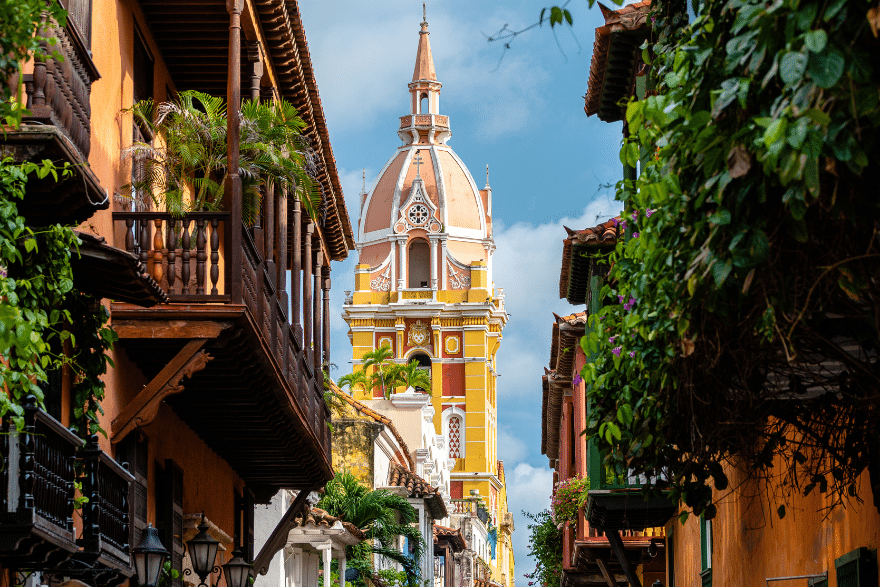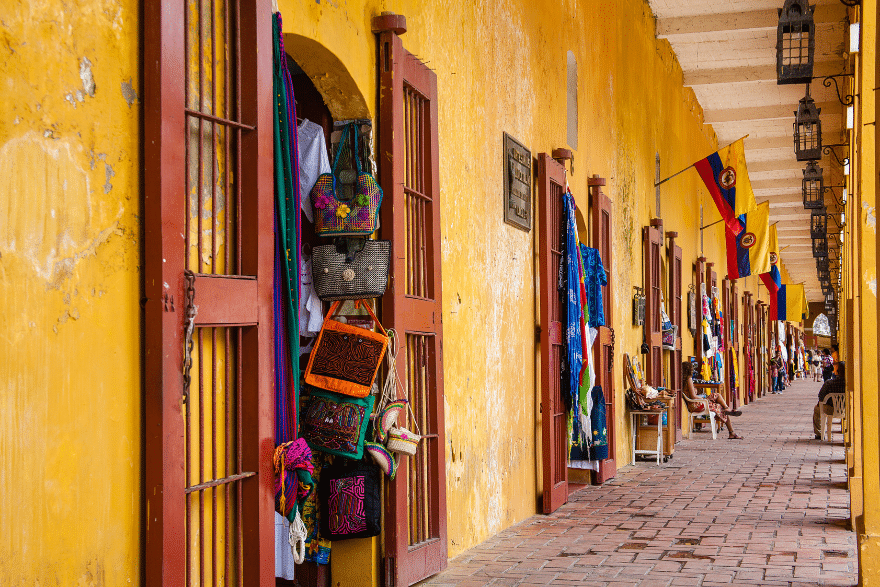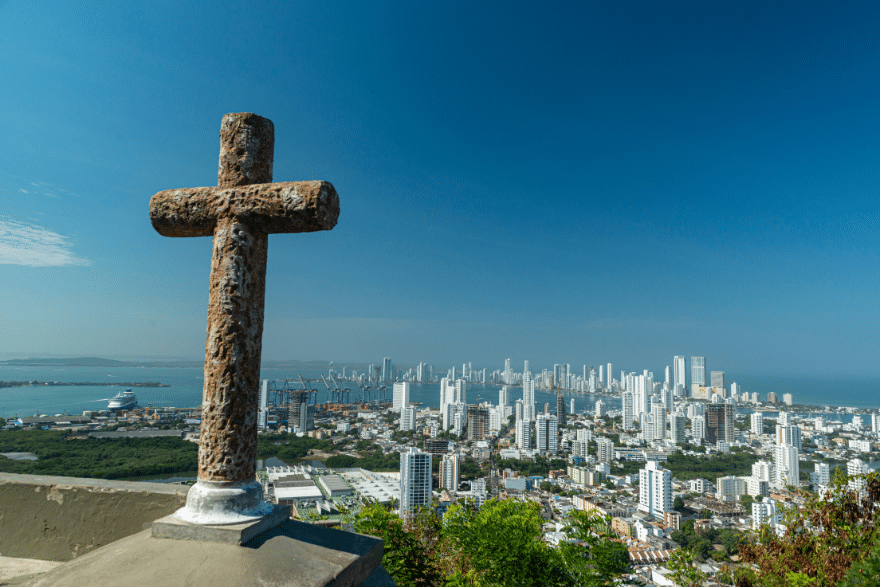Lapped by the warm waters of the Caribbean Sea, Cartagena de Indias is one of the most enchanting destinations in Latin America—and a highlight on many Panama Canal cruises. This coastal city is often described as a living treasure chest, overflowing with vibrant culture, colonial architecture, and centuries of dramatic history.
Founded in the 16th century by Spanish conquistadors, Cartagena quickly became a crucial stronghold in the vast Spanish Empire. Here, immense wealth—gold, silver, emeralds, tobacco, and sugar—was gathered before making the journey back to Europe. Tragically, the city also became the largest slave port in the Americas, receiving captive Africans who were forced into the colonial trade system.
These riches inevitably attracted pirates and raiders, and Cartagena’s past is filled with stories of sieges, ransom demands, and heroic defenses. To protect its wealth, the Spanish built imposing fortifications, including city walls and the iconic Castillo San Felipe de Barajas, perched on a hill to watch over the bay.
Today, visitors can explore this remarkably preserved UNESCO World Heritage Site, where cobblestone streets, colorful mansions, and stunning plazas offer a vivid glimpse into centuries past. Flower-draped balconies, ornate gateways, and weathered cannons overlooking the sea make Cartagena one of the most photogenic cities in the Caribbean. Beyond its historical significance, Cartagena captivates with its tropical beauty, vibrant energy, and timeless charm.
Among the many other treasures you can explore during your visit to Cartagena are a 400 year old cathedral, a palace which was once home to the Spanish Inquisition and a wealth of museums displaying indigenous gold artifacts and emeralds brought forth from Colombian mines. Browse the handicrafts displayed forsale in former dungeon cells, take a pause in the ultimate calm of a convent cloister or drink in incredible views from atop the city walls.
If time is limited, we recommend you start with Cartagena’s old town, within walls, which dates back to the 16th century.
Cartagena’s Old Walled Town

Begin your journey in Cartagena’s Old Town, the city’s most enchanting and historic district. This beautifully preserved area is so rich in colonial architecture and cultural heritage that a simple stroll often feels like stepping onto the set of a period film. Nearly every corner reveals centuries-old wonders—from the massive fortified walls lined with cannons once used to defend the city from pirate attacks to lively plazas framed by grand colonial buildings.
The Old Town is a visual feast, bursting with vibrant colors. Sunshine-yellow facades, bright pink homes, and soft lilac walls create a striking backdrop for ornate wooden balconies overflowing with lush, multicolored flowers. As you explore, look beyond the sweeping beauty to discover the smaller, fascinating details that define Cartagena’s character.
Some highlights are impossible to overlook, such as the palenqueras, the brightly dressed women who are descendants of the Americas’ first free slave community and an enduring symbol of Cartagena’s cultural identity. Other details are more subtle but equally intriguing—like the city’s famous decorative door knockers. These unique designs once signified the profession or status of the families who lived inside. Sea creatures represented merchants; lions signaled military ties; and hand-shaped knockers marked religious households. Today, the tradition continues, with knockers chosen as much for artistic flair as for meaning—so keep your eyes open; you never know what story a door may tell.
There are statues and art everywhere and frequent dance performances in the squares. Occasionally you will come across the surprisingly different such as the exterior wall of the Marzola Parilla Argentina restaurant on Calle 39 covered with mirrors, clocks and shelves of old wine bottles.
The streets resound to the clop of horses hooves (which these days are used to convey visitors on sightseeing tours) and they add considerably to the bygone atmosphere.
The area within the walled city is relatively small and easily explored on foot but so plentiful are the highlights it is impossible to see everything in a short space of time. Nothing short of a fantastic open-air museum, Cartagena’s atmosphere and sights are best soaked up by simply wandering and yet there are a few not-to-be-missed stops.
Torre del Reloj –The Clock Tower
Ornately tiered and bright yellow, the 17th century clock tower is the old city’s most instantly recognizable feature. It sits above the entrance which takes you under and through the imposing walls and was once the site of a drawbridge and moat.
Plaza de Los Coches:
This is the first of the many squares which you arrive at and stepping into this large plaza instantly surrounds you on all sides by Cartagena’s beautiful colonial buildings. If you have a sweet tooth be sureto have a wander beneath the arches here. The stalls you’ll find are packed with glass jars all filled with a mouthwatering range of traditional candies and treats. The practice of selling such things in this very spot is an old one hence the name –the Portal de los Dulces or Candy Hall.
Plaza de San Pedro:

One of the walled city’s loveliest squares, San Pedro is home to a modern art museum housed inside a 1600s custom house and the lovely San Pedro Claver Church. The square is always full of locals, sitting chatting on benches, and also has a wonderful collection of metal sculptures depicting ordinary scenes of life and work such as the seamstress at her sewing machine or two men playing chess.
The 16th century church, constructed between 1580 to 1654, is dedicated to St. Pedro Claver, the patron saint of slaves. It’s also the site of his tomb. While you’re there, pay a visit to Santuario Museo San Pedro Claver, housed in the adjacent cloisers. The museum features exhibits on Afro-Caribbean culture, colonial religious art, and some pre-Colombian archeological pieces, along with the cell where St. Pedro, dedicated to healing the slaves who passed through the port, lived in.
Plaza de Bolivar, Cathedral of Saint Catherine of Alexandria and the Inquisition Palace:
Another candidate for Cartagena’s loveliest square, this leafy, gated space with its fountains sits at the center of the walled town. Often alive with the vibrant colors and sounds of Afro-Colombian dancers staging impromptu performances in the shade of the overhanging trees, the square is dominated by the statue of Simon Bolivar. Known as the Liberator, this Venezuelan military leader is hailed as a hero all over the continent for his role in helping several countries throw off the yoke of Spanish control.
Bordering the square are two of the city’s most historically significant buildings, such as the cathedral and the Inquisition Palace. The cathedral of St. Catherine of Alexandria, also called the Minor Basilica, dates from the late 1500s and is widely accepted to be one of the most beautiful buildings in the Old Town. Topped by a distinctive terracotta and ocher colored tower which features heavily on postcards and tourist literature and was a later addition, the cathedral was the town’s original church and has a beautiful gilded altar inside.
The western side of the square is home to the 18th century Palace of the Inquisition which has a gory and horror-filled past as a place of imprisonment and torture. It’s now a museum The palace is now a museum, displaying the inquisitors’ instruments of torture, some of which are quite horrific. The museum also houses pre-Columbian pottery.
Santo Domingo Square and Santo Domingo Convent:
This bar-and restaurant-filled square represents the Old Town at its most bustling and after dark is the beating heart of its nightlife. Vendors are forever present here while at the center reclines the famous nude statue known as Fat Gertrude (or La Gorda Gertrudis). This lady’s physical characteristics are indeed ample; she’s the work of Fernando Botero she is never short of company as tourists pose for photographs and rub her left breast for luck which has received so much attention it is now showing definite signs of wear.
Dominating the entire scene is the sunshine-yellow 16th century Santo Domingo Convent with its grand portico and square bell-tower which rises from its right-hand edge.
Plaza de las Bovedas:

Forming the north-west extremity of the old walled town, the elegant arches of Las Bovedas are today home to artisans and vendors selling their wares and handicrafts.
This 18th century building, which was to be the last erected by the Spaniards in their grand colonial style, was originally used to house military supplies but was turned into a series of dungeons in the early 1800s as the populace started to fight back against Spanish rule. With the waters of the Caribbean Sea just meters away, the story is often told that those who were unfortunate enough to find themselves imprisoned here would have to suffer frequent flooding of their cells at each high tide.
Today, these very same cells sitting beneath almost 50 arches are each home to a small shop. Here you can find such things as hammocks, handmade bags, jewelry, paintings and unusual home-wares making Las Bolvedas –which means the vaults or the caverns in Spanish –the ideal place to come for all those hunting down gifts and souvenirs.
The walls:
There are several sections of the Old Town walls where you can climb atop and wander amid the ancient structures and past rusting cannons. Most of these come complete with fantastic views of the Caribbean and with sometimes sweeping elevated look-outs over the majestic old churches, convents, palaces and parks. One of these is the Bulwark of Saint Dominic which is located at the extreme western edge of the town.
Beyond the Old City
If you’re keen to expand your surroundings, head outside the old town walls. Here are some of our favorite sites beyond the old city:
The Convent of Santa Cruz de la Popa:

The beautiful Convent of Santa Cruz de la Popa is located 5km from the Old Town’s iconic clock tower and perched atop the city’s highest point on a hill covered in tropical greenery. Such a separation, albeit small, combined with the almost overwhelming quantity of riches contained within the Old Town which take up the entire attention of the majority of visitors mean the convent is often overlooked and far less visited.
It shouldn’t be.
This former religious complex of the Augustinian friars, which dates from the 1600s, doesn’t take long to explore although you may find it difficult to tear yourself away from the exquisitely gorgeous enclosed cloister. Filled with plants and trees and spilling tropical blooms from all sides, the cobblestones are surrounded by two levels of arches and beautiful architecture which weave a dappled tapestry of cool shade and bright sunlight.
Unprotected by the imposing walls which surround the Old Town, the convent has suffered various attacks over the centuries and has been subject to several restorations giving it a slightly patchwork aspect. Ironically, this only adds to its charm. Much of the convent’s history is unknown as what historical records there were perished during various raids and onslaughts.
The small chapel with its ornate gold altar is beautiful to see and the small museum interesting but perhaps the scene-stealer of any trip here is the million-dollar view. From atop this hill you can take in all of Cartagena –both ancient and modern –with the sparkling Caribbean and islands forming the backdrop.
An alternative to the Santa Cruz Convent –the San Felipe Fortress:
Another must-see Cartagena sight is also, like the convent, found outside the city walls, this time just 1km away from the clock tower and easily reached on foot.
Widely considered to be the best example of Spanish colonial military architecture found anywhere in the Americas, the 16thcentury San Felipe castle is a UNESCO World Heritage Site. Strategically sited atop San Lazaro hill to command views over potential attacks approaching by both land and sea, this imposing structure is a labyrinth of tunnels and passageways, all of which can be explored. Head up to the parapets for some fantastic views of the bay and city.
Cartagena’s passion for bird life:

Did you know that this part of Colombia is famous for attracting a huge diversity of bird species? Consider a trip to the National Aviary, where a number of observation stations are arranged by habitat and species. Set in a beautiful landscape with waterfalls and palm trees, you can visit the Tropical Forest, with its Harpy Eagles, macaws and Macaque Monkeys. In Coastlines and Mangroves you’ll see ducks, cormorants and pelicans, and on the Coastline, you’ll observe herons, doves and storks. The National Aviary is about a 40-minute drive from Cartagena, on the Isla du Baru, and Windstar offers it as a shore excursion.




















































